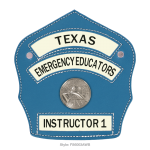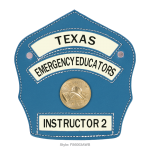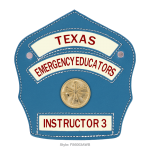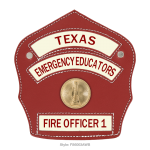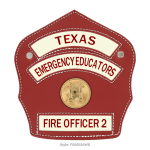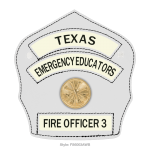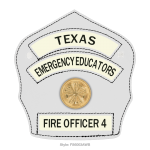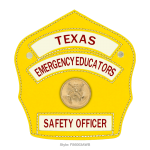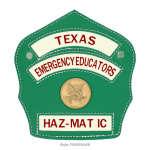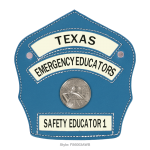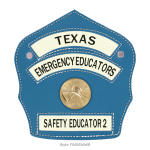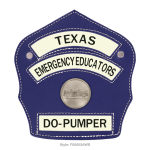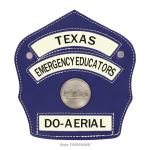Texas Commission on Fire Protection
Instructor 1
NFPA Definitions of Certification Levels
Instructor I: A fire service instructor who has demonstrated the knowledge and ability to deliver instruction effectively from a prepared lesson plan, including instructional technology tools and evaluation instruments; adapt lesson plans to the unique requirements of the students and authority having jurisdiction; organize the learning environment so that learning and safety are maximized; and meet the record-keeping requirements of authority having jurisdiction.
A Fire Instructor I is a fire service instructor who has demonstrated the knowledge and ability to:
• Deliver instruction effectively from a prepared lesson plan, including instructional aids and evaluation instruments
• Adapt lesson plans to the unique requirements of the students and authority having jurisdiction (AHJ)
• Organize the learning environment so that learning is maximized • Meet the record-keeping requirements of the AHJ
$250.00
Instructor 2
NFPA Definitions of Certification Levels
Instructor II: A fire service instructor who, in addition to meeting Instructor I qualifications, has demonstrated the knowledge and ability to develop individual lesson plans for a specific topic including learning objectives, instructional technology tools, and evaluation instruments; schedule training sessions based on overall training plan of authority having jurisdiction; and supervise and coordinate the activities of other instructors.
A Fire Instructor II is a fire service instructor who, in addition to meeting Instructor I qualifications, has demonstrated the knowledge and ability to:
• Develop individual lesson plans for a specific topic including learning objectives, instructional aids, and evaluation instruments
• Schedule training sessions based on overall training plan of the authority having jurisdiction (AHJ)
• Supervise and coordinate the activities of other instructors
$300.00
Instructor 3
NFPA Definition of Certification Level
A fire service instructor who, in addition to meeting Instructor II qualifications, has demonstrated the knowledge and ability to develop comprehensive training curriculum and programs for use by single or multiple organizations; conduct organization needs analysis; design records management and scheduling systems; and develop training goals and implementation strategies.
A Fire Instructor III is a fire service instructor who, in addition to meeting Instructor II qualifications, has demonstrated the knowledge and ability to:
• Develop comprehensive training curriculum and programs for use by single or multiple organizations
• Conduct organization needs analysis
• Develop training goals and implementation strategies
$300.00
Officer 1
Fire Officer I:
A Fire Officer I is a first-line supervisory officer who has met all the job performance and
certification requirements of Fire Officer I as defined in NFPA 1021, Standard for Fire
Officer Professional Qualifications and has previously met all the job performance and
certification requirements of Fire Fighter II as defined in NFPA 1001, Standard for Fire
Fighter Professional Qualifications, and Fire Instructor I as defined in NFPA 1041,
Standard for Fire Service Instructor Professional Qualifications.
FIRE OFFICER I
A Fire Officer I is a first-line supervisory officer who has met all the job performance and
certification requirements of Fire Officer I as defined in NFPA 1021, Standard for Fire
Officer Professional Qualifications and has previously met all the job performance and
certification requirements of Fire Fighter II as defined in NFPA 1001, Standard for Fire
Fighter Professional Qualifications, and Fire Instructor I as defined in NFPA 1041,
Standard for Fire Service Instructor Professional Qualifications. An individual at the Fire
Officer I level, as part of his or her duties and responsibilities performs the following:
• Uses human resources to accomplish assignments in accordance with safety
plans in an efficient manner, evaluates member task performance, supervises
personnel during emergency, and non-emergency work periods
• Deals with inquiries from the community, projects the role of the department to
the public, delivers safety, injury prevention and fire prevention education
programs
• Performs general administrative functions and implements departmental policies
and procedures at the unit/company level
• Performs a fire investigation to determine preliminary cause, secures the incident
scene, and preserves evidence
• Supervises emergency operations, conducts pre-incident planning, and deploys
assigned resources in accordance with the local emergency plan
• Integrates safety plans, policies, and procedures into the daily activities as well
as on the emergency scene, including the donning of appropriate levels of
personal protective equipment to ensure a safe work environment, in accordance
with health and safety plans, for all assigned members
$250.00
Officer 2
Fire Officer II:
A Fire Officer II is a mid-level supervisor who performs both supervisory and first-line
managerial functions who has met the certification requirements for Fire Officer II, in
addition to previously meeting all the job performance and certification requirements of
Fire Officer I as defined in NFPA 1021, Standard for Fire Officer Professional
Qualifications.
FIRE OFFICER II
A Fire Officer II is a mid-level supervisor who performs both supervisory and first-line
managerial functions who has met the certification requirements for Fire Officer II, in
addition to previously meeting all the job performance and certification requirements of
Fire Officer I as defined in NFPA 1021, Standard for Fire Officer Professional
Qualifications. An individual at the Fire Officer II level as part of his or her duties and
responsibilities:
• Evaluates member job performance
• Prepares a project or divisional budget, news releases, and/or new policy or
changes in existing policies
• Conducts inspections to identify hazards and addresses violations and conducts
fire investigations to determine origin and preliminary causes
• Supervises multi-unit emergency operations, deploys assigned resources, and
develops and conducts post-incident analysis
• Reviews injury, accident, and health exposure reports, identifies unsafe work
environments or behaviors, and takes approved action to prevent their
re-occurrence
$300.00
Officer 3
Fire Officer III:
A Fire Officer III is a midlevel supervisor who performs both supervisory and first-line managerial functions who has met all the job performance and certification requirements of Fire Officer II as defined in NFPA 1021, Standard for Fire Officer Professional Qualifications. Typical duties of an individual at the Fire Officer III level include: establishing procedures for hiring, assignment, and professional development of personnel; developing public service/partnership and programs; preparing budgets and budget management systems; planning for organizational resource management; evaluating inspection and public safety programs and plans; managing multi-agency plans and operations; serving as Incident Commander at expanding emergency incidents for all hazard types; and developing and managing a departmental safety program.
$300.00
Officer 4
Fire Officer IV:
A Fire Officer IV is an upper level supervisor who performs both supervisory and managerial functions who has met all the job performance and certification requirements of Fire Officer III as defined in NFPA 1021, Standard for Fire Officer Professional Qualifications. Typical duties of an individual at the Fire Officer IV level include: Administering job performance requirements; evaluating and making improvements to department operations; developing long-range plans and fiscal projections; developing plans for major disasters; serving as Incident Commander at major incidents for all hazard types; and administering comprehensive risk management programs.
$300.00
Incident Safety Officer
Definition of an Incident Safety Officer
An Incident Safety Officer is an individual who has met the requirements of Fire Officer Level I specified in NFPA 1021, Standard for Fire Officer Professional Qualifications and Chapter 5 of NFPA 1521, Standard for Fire Department Safety Officer and has the knowledge, skill, and abilities to manage incident scene safety by having and maintaining a knowledge of:
• Fire suppression operations,
• Technical rescue operations,
• Hazardous materials operations,
• Building construction,
• Fire science and behavior relative to predicting hostile fire events,
• The Incident Command System,
• The fire department’s personnel accountability system,
• Incident scene rehabilitation strategies,
• The accident investigation and review process,
• Post-Incident analysis procedures.
Additional Incident Safety Officer duties include:
• Risk evaluation
• Resource evaluation
• Hazard identification and communication
• Action plan review
• Safety briefings
• Collapse zoning
• Safety committee participation
$300.00
Hazardous Materials Incident Commander
NFPA 472 Definitions of Certification Levels
Haz-Mat Incident Commander: The Hazardous Materials Incident Commander is defined as that person responsible for all incident activities, including the development of strategies and tactics and the ordering and release of resources.
NFPA 472: Standard for Competence of Responders to Hazardous
Materials/Weapons of Mass Destruction Incidents, Chapter 8 provides requirements for
competencies for incident commanders responsible for the on-scene management of hazardous
materials emergencies and is the primary response industry standard. NFPA 472 is written from
a broad perspective - establishing a framework that can be applied to a wide variety of incidents
regardless of the hazardous material(s) that may be involved, but does not provide product
specific guidance for individual products, such as the crude oil or ethanol.
$300.00
Fire & Life Safety Educator 1
NFPA Definitions of Certification Levels
Fire & Life Safety Educator 1: A Fire and Life Safety Educator I is an individual who has met the requirements specified in chapter 4 of NFPA 1035, Standard on Fire and Life Safety Educator, Public Information Officer, Youth Firesetter Intervention Specialist, and Youth Firesetter Program Manager Professional Qualifications, 2015 edition and has the knowledge, skill, and abilities to provide fire and life safety education programs by:
• Documenting fire and life safety educational activities
• Maintaining work schedules
• Identifying and partnering with community resources, services and organizations
• Selecting instructional materials
• Assuring safety during fire and life safety education activities
• Presenting and adapting lessons
• Publicizing fire and life safety information
• Disseminating educational information
• Administering and scoring evaluation instruments
$300.00
Fire & Life Safety Educator 2
NFPA Definitions of Certification Levels
Fire & Life Safety Educator 2: A Fire and Life Safety Educator II is an individual who has met the requirements specified in chapter 5 of NFPA 1035, Standard on Fire and Life Safety Educator, Public Information Officer, Youth Firesetter Intervention Specialist, and Youth Firesetter Program Manager Professional Qualifications, 2015 edition and has the knowledge, skill, and abilities to provide fire and life safety education programs by:
• Preparing program budgets
• Developing public policy recommendations for management
• Evaluating subordinate performance
• Establishing fire and life safety education priorities
• Facilitating partnerships
• Requesting resources from external organizations
• Designing and revising education programs to include informational materials, lesson plans and educational materials
• Developing and implementing program evaluation strategies
• Designing program evaluation instruments
• Implementing an evaluation strategy
$300.00
Driver/Operator-Pumper
NFPA Definitions of Certification Levels
Driver/Operator - Pumper: A Driver/Operator is an individual who has met the requirements of NFPA 1002, Standard for Fire Apparatus Driver/Operator Professional Qualifications and has the knowledge, skills, and abilities to drive and operate an apparatus by having and maintaining a knowledge of:
• Apparatus inspections and basic maintenance
• Best practices for ensuring the safety of all personnel riding in the apparatus while it’s in motion
• Techniques for safe driving of an apparatus to and from an incident scene
• Appropriate positioning of the apparatus to maximize effectiveness
• Techniques for safe operation of apparatus equipment and components
$350.00
Driver/Operator-Aerial
NFPA Definitions of Certification Levels
Driver/Operator - Aerial: A Driver/Operator is an individual who has met the requirements of NFPA 1002, Standard for Fire Apparatus Driver/Operator Professional Qualifications and has the knowledge, skills, and abilities to drive and operate an apparatus by having and maintaining a knowledge of:
• Apparatus inspections and basic maintenance
• Best practices for ensuring the safety of all personnel riding in the apparatus while it’s in motion
• Techniques for safe driving of an apparatus to and from an incident scene
• Appropriate positioning of the apparatus to maximize effectiveness
• Techniques for safe operation of apparatus equipment and components
$350.00
